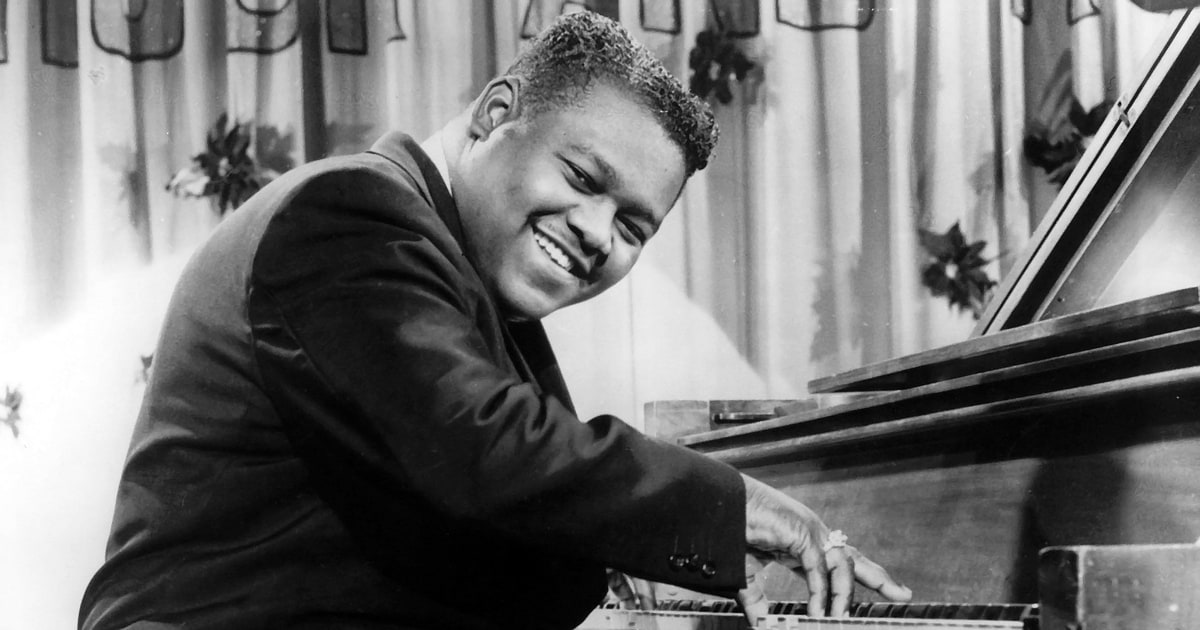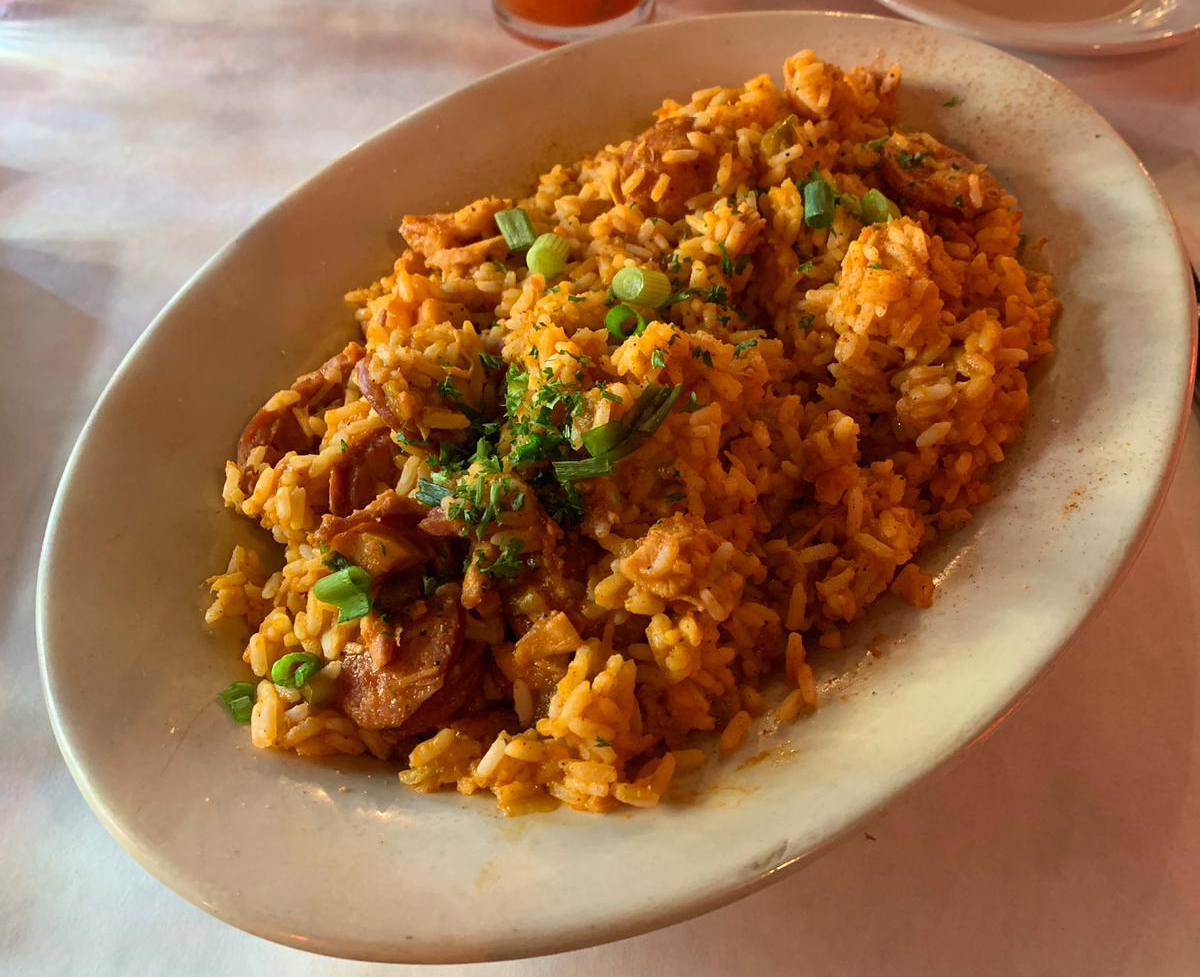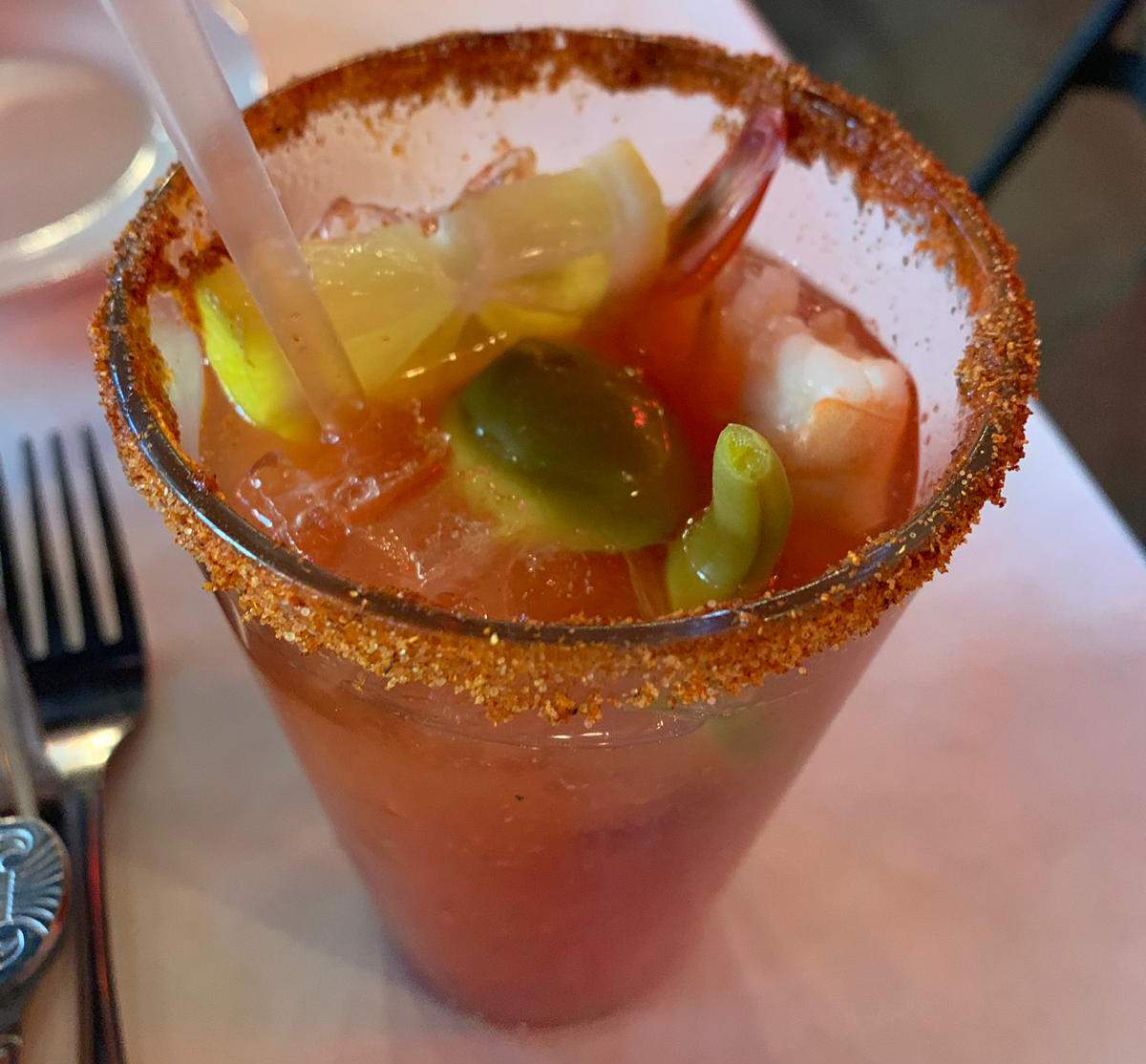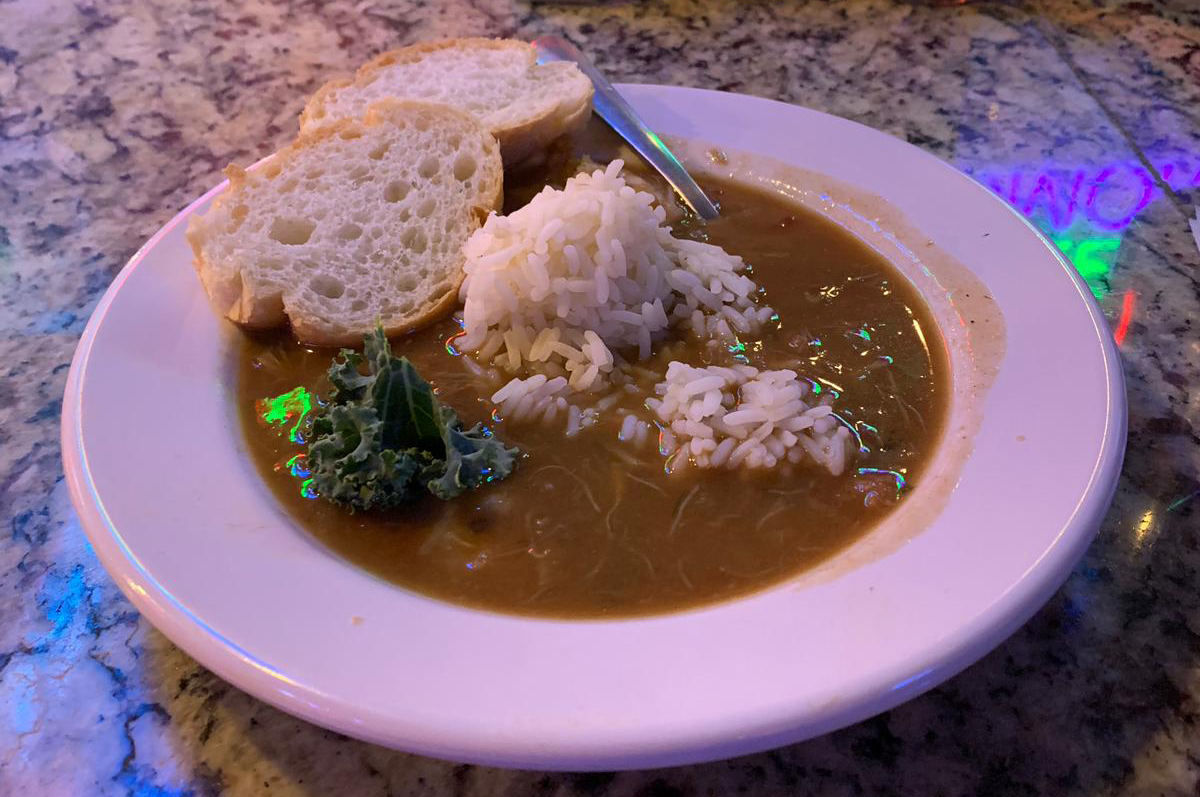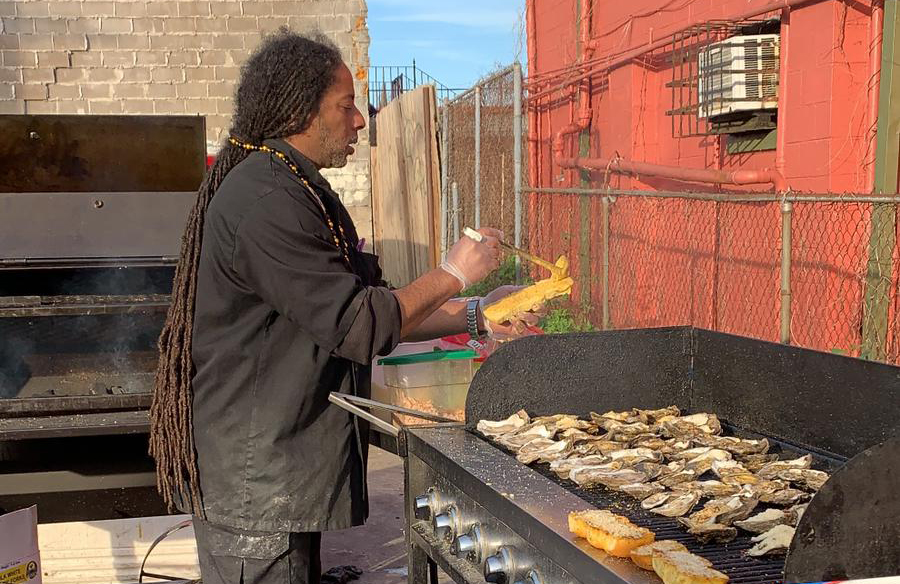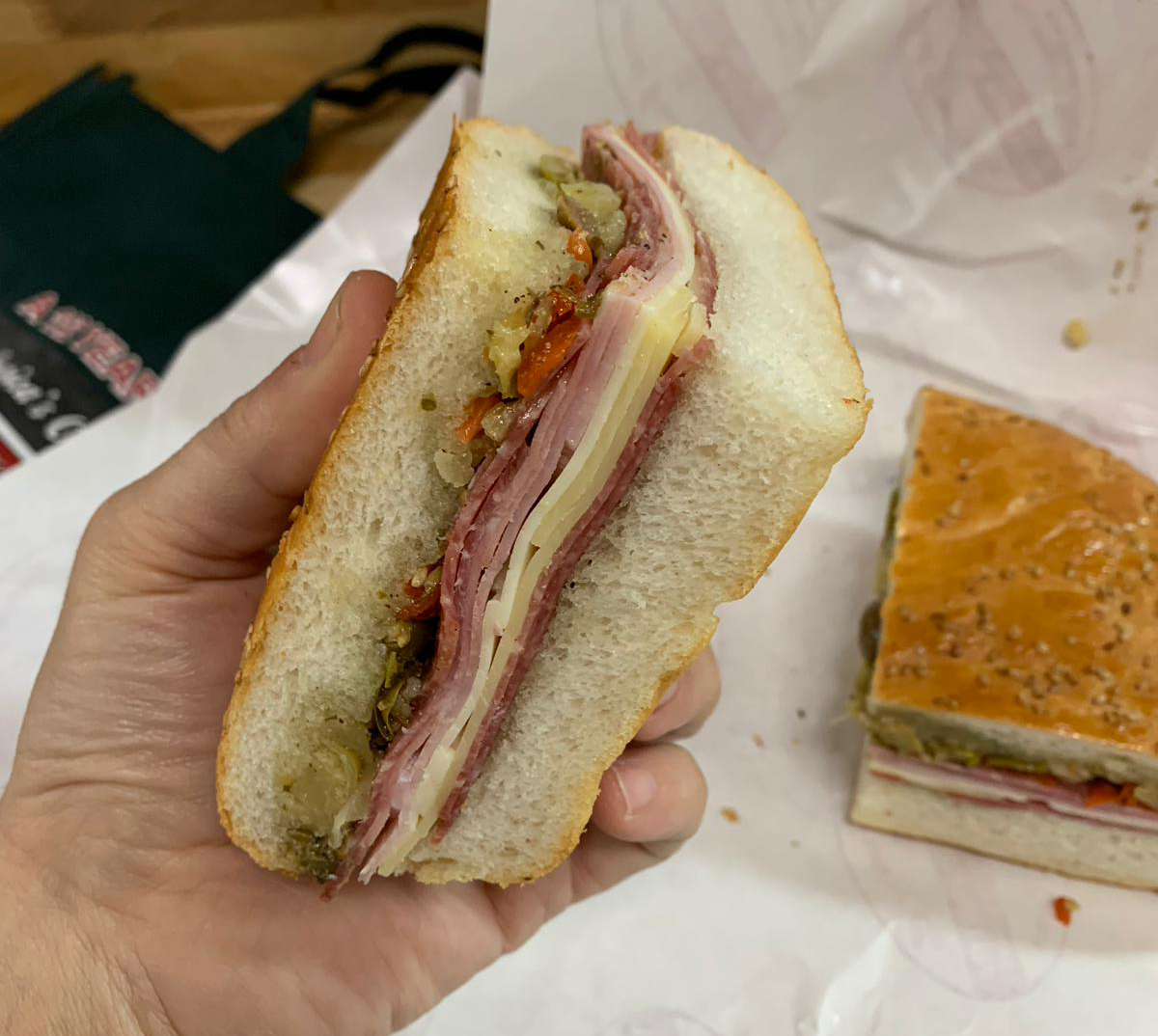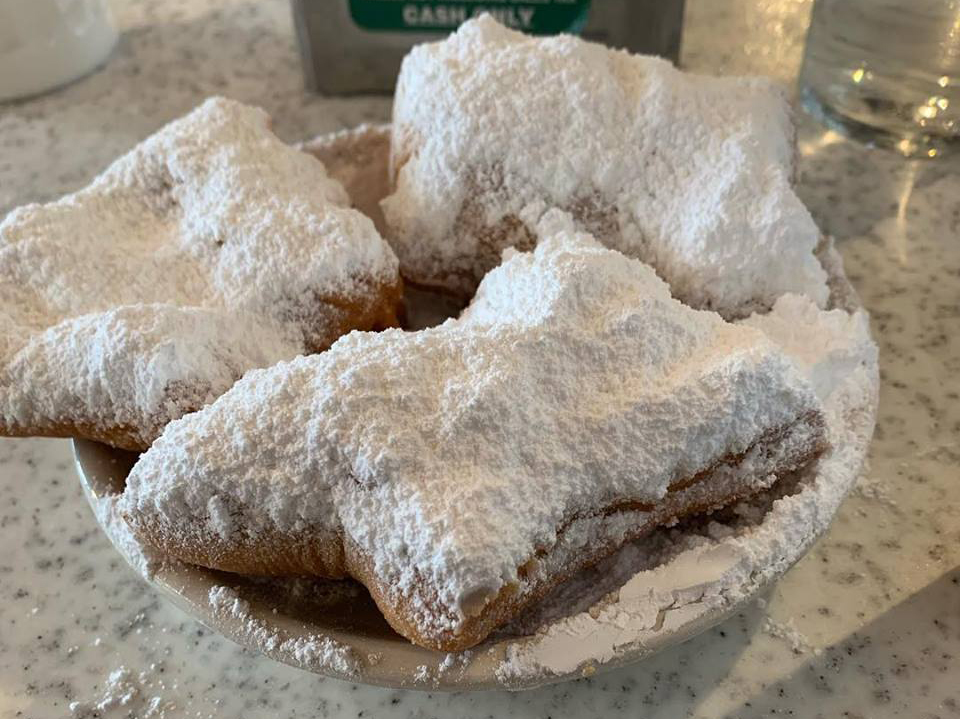It’s a warm summer night, the moon is shining and her light beams glitter on the surface of the freshwater of a bay of the Mississippi delta, thus framing warm and spicy crustaceans. This is the perfect scenario for a charming date with the beautiful Yvonne.
Soft music in the background is the marked deep voice of Fats Domino, the city icon, that reinterprets Jambalaya (On the Bayou), the evergreen country-blues by Hank Williams, composed for his beloved Yvonne.
Fats Domino (New Orleans, 1928 – Harvey, 2017). The voice of New Orleans, leader of rhythm and blues between the Fifties and Sixties, with his band he reinterpreted a jazzy version of the piece Jambalaya (On the Bayou) by Hank Williams Jr., 1952.
On the theme of “Jambalaya and a crawfish pie and fil gumbo / ‘cause tonight I’m gonna see my ma cher amio”, the atmosphere becomes warm and sensual, alluding to the hot exotic shades of the jambalaya, the crawfish pie and the gumbo, three extraordinary works of art, ambassadors of the culinary creole and Cajun of New Orleans.
To understand New Orleans, it is necessary to look at her geographically: wedged on the majestic delta of the powerful Mississippi. Like any other city sitting on river deltas, her relationship with water is not linear (longitudinal as in coastal cities, transversal as in fluvial cities); rather it is complex and deep. Water appears where you least expect it, sweet and salty at the same time like her food, precious and painful like her story, with a beginning and end like her parades.
Once again, it happens in a port city (the port of New Orleans is the second biggest of the United States, only second to New York) that different cultures, ethnic groups, social classes, colors, flavors, lifestyles, languages, rituals, sounds, local prime materials and imported goods mingle so perfectly to consolidate in established traditions.
Like the delta where she rises, New Orleans is a fractal city; the more you try to discover her, the more the details that enrich her that unveil her even more and every traditions hides within an another tradition that hides within another one and then another one and so on like a Matryoshka.
New Orleans is popular for the creole and cajun kitchen, two mixtures of French, Spanish, Portuguese, Italian, African and central-american cooking, that fully mirror the story and character of the city.
French and Spanish fought for Nouvelle Orléans many times in the eighteenth century, while in the nineteenth century, thanks to the huge harbor connected to 23.300 Km of inner sailing routes, the city became one of the main trading hubs between Europe, South America and Caribbean. From New Orleans, the vast majority of whole United States internal production – cereals, cotton, petrol, food – is exported; other goods from Latin America – cocoa, coffee and bananas -, prime material from Europe and slaves from Africa are imported.
And so it happens that the Creole cuisine, reserved to the aristocrats and the very rich owners of cotton plantations, arises from the adaptation of European culinary traditions (above all the Spanish ones) to the local goods, while the Cajun cuisine, travelling from France to Canada and from Canada to Louisiana by the Acadian settlers, changed recipes and ingredients according to which prime material was available in the newly colonized countries.
In New Orleans the two cooking often fused together to give rise to real works of art such as the jambalaya “of the beautiful Yvonne”. Very likely born as a creole attempt to reinvent the Spanish paella, the American tomato replaces saffron, and a radical twist is given by the choice of the Caribbean spices that find their moment of triumph in the Cajun version. Here, prawns and sausages happily show off accompanied by a crunchy rice, garnished with the fundamental “holy trinity” made by celery, onions and bell peppers.
Yambalaya, served in the restaurant New Orleans Creole Cookery Seafood, Toulouse Street 508, French Quarter.
The crawfish pie derives from the Cajun tradition hat was capable to fully exploit the more abundant food available in the bayou: the freshwater prawn, that has happily colonized the ecosystem of Mississippi delta, characterized by slow rivers, ponds and swampy lakes. The recipe, that has as a base a pie, a lot of prawn on top, butter, white pepper, black pepper and cayenne pepper, the always present “holy trinity”, clearly shown similarities with the French kisch, rustic savory pies loved by French farmers.
There is so much prawn around that it sneaks not only into pies, but also swims inside the glasses of long drinks Cajun Bloody Mary, super spicy cocktail served in New Orleans Creole Cookery Seafood, in the French quarter, the oldest area of historical center. Luckily, also fantastic bourbon and great rum are also available…!
Cajun Bloody Mary, served in the restaurant Orleans Creole Cookery Seafood, Toulouse Street 508, Ffrench quarte.
The gumbo is a Cajun recipe adopted by the Creole cuisine. The base is the bouillabaisse of Marseille, where spices of Provence are replaced by filé powder, a spice obtained from sassafras leaves, very aromatic and with agglutinating and anti-inflammatory properties, where the original recipe was passed on by the of American Indians.
The special talent of the gumbo is inherent in the okra pod, a plant originary from tropical Africa, due to its jelly liquid guarantees creaminess to the soup, and in the brown roux, a mixture of oil and flour cooked to brown before adding it to the soup. The ingredients are often prawns (…of course!) lobsters, oysters, molluscs and other kinds of fish, or a variety of meats. Always there the “holy trinity”, yet this time mixed with another “holy trinity” readapted by the Cajun tradition and constituted by thyme, Worchester sauce and Tabasco.
Compared any other soup in the world is its creaminess, guaranteed by brown roux, sassafras and okra, that renders this recipe so unique!
Fish gumbo served in the restaurant Oceana Grill, 739 Conti Street.
Contaminations and gambles: that’s what New Orleans is! She can seduce you all in a sudden with a bbq with oysters grilled on their half shell, garnished with butter and cheese, filled with crab and prawns, decorated with sauteed mixed vegetables and served with bread spread with Cajun sauce and cheese. All these gastronomic notes donate a sublime symphony to the palate, first, to the soul, after. Like jazz, that right in New Orleans was played by African slaves and has on top of the list Louis Armstrong as the most important artist.
Oyster Bienville prepared as street food on a barbecue improvised on a street of the Treme quarter.
Great success for a Sicilian invention, the muffuletta, a little focaccia bread as big as the palm of a hand that in Palermo is garnished with anchovies and grated caciocavallo cheese; imported in New Orleans by the Sicilian businessman Salvatore Lupo, muffuletta is here proposed in the American size version, enriched by a filling of cured ham, cheese, gherkin and vegetables.
Muffuletta at the Central Grocery in Decatur Street.
Synecdoche of the city is the Café du Monde; cul de sac of humanity, that has welcomed and comforted generations of women and men traveling though New Orleans, known for its black coffee and the famous beignets. An heritage passed on by Acadians, these fried sweet doughnuts are neatly covered in icing sugar which, after the first couple of bites, expect to find it all over your clothes! But be joyful as your body will be then lifted by the lightness of New Orleans!
That’s when you begin to understand New Orleans, her being place and world, matrix of a urban cosmopolitanism.
Beignets at the Café du Monde.
In a city that remixes everything and generates life to the rhythm of jazz, parades are a periodic appointment throughout the year. Among the most important, the Mardi Gras Parade, a celebration that mingles players and watchers and where after a little while everybody turns into “the parade”. Is a cheerful game between those who shows off to gain the other’s attention and seduce to receive gifts thrown on the parade carriages. With the night getting longer and longer, the battle of receiving a colourful necklace turns into a proper game of seduction between women and men, standing in crowded balconies of the French District, epicenter of celebration, of love and freedom, where every mask reveals its real soul, hidden behind serious outfits during the rest of the year.
At the end of the parade everyone goes back home with a rich loot, which mirrors one’s will to get in the game to win, amongst the thousands of hands, the trinket thrown by the beautiful Yvonne!
Mardi Gras Parade, necklaces throw from the balconies by a celebrating crowd.
English translation by Ester Badami
Head Image: Image of the sign of the restaurant Oceana Grill in the French neighbour of New Orleans. Here dishes typical of the creole and cajun cooking are served, Po’ Boy and much more of the local gastronomic cultures.
La bella Yvonne della Louisiana
Gli argentei soffusi riverberi della luce della luna in una calda notte d’estate, rispecchiati dalle acque di una baia del delta del Mississippi, fanno da sfondo a crostacei caldi e piccanti per un appuntamento galante con la bella Yvonne.
In sottofondo, il profondo timbro vocale di Fats Domino, icona della città, reinterpreta Jambalaya (On the Bayou), l’evergreen country-blues composto e interpretato da Hank Williams per la sua amata Yvonne.
Fats Domino (New Orleans, 1928 – Harvey, 2017). La ‘voce’ di New Orleans, protagonista del rhythm and blues tra gli anni Cinquanta e Sessanta, con la sua band ha reinterpretato in chiave jazz il brano Jambalaya (On the Bayou) di Hank Williams Jr. del 1952.
Sulle strofe “Jambalaya and a crawfish pie and fil gumbo / ‘cause tonight I’m gonna see my ma cher amio”, l’atmosfera si fa densa e sensuale, alludendo alle piccanti sfumature esotiche della jambalaya, della crawfish pie e del gumbo, tre straordinarie opere d’arte ambasciatrici delle tradizioni culinarie creole e cajun di New Orleans.
Per capire New Orleans occorre osservarla geograficamente: incastonata sul maestoso delta del potente Mississippi. Come tutte le città sui delta dei fiumi, il suo rapporto con l’acqua non è lineare (longitudinale come le costiere, trasversale come le fluviali), ma è complesso, immersivo: l’acqua si palesa dove non te lo aspetti, dolce e salata al contempo come il suo cibo, preziosa ma fonte di dolore come la sua storia, inizio e fine come le sue parate.
Ancora una volta accade in una città portuale (il porto di New Orleans è il secondo più grande degli USA, dopo quello di New York) che l’incontro tra diverse culture, etnie, classi sociali, colori, sapori, stili, linguaggi, rituali, sonorità, materie prime locali e prodotti importati generi invenzioni talmente perfette da consolidarsi in tradizioni.
Come il delta su cui sorge, New Orleans è una città frattale, più cerchi di conoscerla e più si arricchisce di particolari che te la fanno riscoprire, e ogni tradizione ne contiene dentro un’altra, ed essa a sua volta un’altra ancora.
A New Orleans si distinguono la cucina creola e quella cajun, a loro volta straordinari meticciati delle cucine francese, spagnola, portoghese, italiana, africana e centroamericana che riflettono in tutto e per tutto la storia e il carattere della città. Francesi e spagnoli si sono contesi Nouvelle Orléans a più riprese nel diciottesimo secolo, mentre nel diciannovesimo, grazie al suo grandissimo porto collegato a 23.300 chilometri di vie navigabili interne, la città diviene uno dei principali hub di import/export con Europa, Sud America e Caraibi. Transita in uscita la maggior parte della produzione interna di quasi tutti gli USA – cereali, cotone, prodotti petroliferi e alimentari – e in entrata cacao, caffè e banane dall’America Latina, materie prime e prodotti europei, schiavi dall’Africa.
E avviene così che la cucina creola, quella degli aristocratici e dei ricchissimi padroni delle piantagioni di cotone, nasce dall’adattamento delle tradizioni culinarie europee (in particolare spagnole) agli alimenti locali, mentre la cucina cajun, trasportata dalla Francia al Canada e dal Canada in Louisiana dai coloni acadiani, abbia modificato dosi e ingredienti della meno sofisticata cucina provinciale francese sempre in funzione della disponibilità degli ingredienti di base.
A New Orleans le due cucine spesso si fondono per dar vita a capolavori come la jambalaya ‘della bella Yvonne’. Probabile tentativo di adattamento creolo della paella spagnola, dove il pomodoro americano viene usato come succedaneo dello zafferano, e riceve una trasformazione radicale con l’utilizzo delle spezie caraibiche aggiunte nella versione cajun. Ed ecco che gamberetti e salsicce trionfano insieme al riso croccante, condito con l’immancabile “holy trinity” di sedano, cipolle e peperoni.
Yambalaya, servita nel ristorante New Orleans Creole Cookery Seafood, al numero 508 di Toulouse Street nel Quartiere Francese.
La crawfish pie deriva invece dalla tradizione cajun che ha saputo valorizzare appieno l’alimento disponibile più in abbondanza nel bayou: il gamberetto d’acqua dolce, che regna felice nell’ecosistema del delta del Mississippi caratterizzato da corsi d’acqua lenti, acquitrini e laghi paludosi. La ricetta, che utilizza una base per torta, gamberetti in abbondanza, burro, pepe bianco, nero e di cayenna e l’immancabile “holy trinity”, ha evidenti corrispondenze con le kisch francesi, le torte rustiche salate della tradizione contadina.
Il gambero non si intrufola soltanto nel ripieno delle torte ma si tuffa anche dentro i long drink, come nel Cajun Bloody Mary, piccantissimo cocktail servito al New Orleans Creole Cookery Seafood, al numero 508 di Toulouse Street nel Quartiere Francese, il più antico nucleo della città. Per fortuna ci si può rifare con ottimi bourbon e splendidi rum!
Cajun Bloody Mary, servito nel ristorante New Orleans Creole Cookery Seafood, al numero 508 di Toulouse Street nel Quartiere Francese.
Il gumbo è ancora un piatto nato dalla cucina cajun ma adottato anche da quella creola. La matrice del piatto è la bouillabaisse marsigliese, dove le spezie provenzali sono sostituite dal filé powder, spezia ricavata dalle foglie del sassofrasso, molto aromatiche e con proprietà addensanti e antipiretiche, la cui ricetta originaria è stata tramandata dagli indiani nativi d’America.
Lo speciale talento del gumbo risiede nell’utilizzo dei baccelli dell’okra, pianta originaria dell’Africa tropicale, che con il loro liquido gelatinoso assicurano la cremosità alla zuppa, e dal roux bruno, il composto di olio e farina fatto imbiondire prima di procedere alla preparazione. Gli ingredienti sono spesso gamberi, aragoste, ostriche, molluschi e altri pesci, oppure varie varietà di carni. Sempre presente la “holy trinity”, ma questa volta in sestetto con l’altra “holy trinity” della cucina cajun costituita da timo, salsa Worchester e Tabasco.
In confronto con qualsiasi altra zuppa al mondo, è proprio la cremosità assicurata dal roux, dal sassofrasso e dall’okra a fare la differenza!
Gumbo di pesce, servito nel ristorante Oceana Grill, 739 Conti Street.
Contaminazioni e azzardi: New Orleans è così! Può sedurti all’improvviso con un bbq all’aperto sul quale grigliano ostriche sulla loro mezza conchiglia, condite con burro e formaggio, farcite con polpa di granchio e gamberetti, arredate con verdure miste saltate e cavallerescamente accompagnate da pane abbrustolito ricoperto di salsa cajun e formaggio. Tutte queste note gastronomiche danno una sublime sinfonia al palato, prima, e all’anima, dopo. Come il jazz, che proprio a New Orleans ha avuto i suoi albori tra gli schiavi dell’Africa e i suoi più grandi interpreti come Louis Armstrong.
Oyster Bienville preparate come street food su un barbecue improvvisato su una strada del quartiere di Treme.
Grande successo riscuote in città una piccola invenzione tutta siciliana, la muffuletta, una piccola focaccia non più grande del palmo di una mano che a Palermo viene condita con acciughe salate e caciocavallo grattugiato; importata a New Orleans dall’imprenditore siciliano Salvatore Lupo, la muffuletta viene riproposta in versione American size, arricchita nella farcitura con salumi, formaggi, sottaceti e verdure.
Muffuletta al Central Grocery in Decatur Street.
Sineddoche della città è il Café du Monde, angiporto di umanità che ha accolto e confortato generazioni di donne e uomini che sono passati da New Orleans con il suo caffè nero e i suoi celeberrimi beignets, eredità portata dagli Acadiani consistenti in frittelle dolci ricoperte di zucchero a velo, che dopo i primi morsi si trasferisce sui vestiti, arricchendoli della leggerezza di New Orleans. Capire New Orleans inizia da qui, dal suo essere luogo e mondo, matrice di un cosmopolitismo urbano.
Beignets al Café du Monde.
In una città che remixa tutto e che genera vita al ritmo del jazz, le parate sono un appuntamento costante che scandisce tutto l’arco dell’anno. Tra le più importanti è la Mardi Gras Parade, un rito che miscela celebranti ed astanti e dopo poco tutti noi si diventa ‘la parata’, in un gioco allegro tra esibirsi per ricevere l’ammirazione del pubblico e sedurre per ricevere i doni delle maschere sui carri. Più la notte si fa fonda, più il gioco di ricevere il dono di una collana colorata si trasforma in tenzone sensuale con le donne e gli uomini che affollano i balconi del French District, epicentro dei festeggiamenti, degli amori e delle libertà, dove ogni maschera svela la vera anima celata tutto l’anno dietro seriose uniformi.
Alla fine ognuno torna con un ricco bottino che è lo specchio della voglia di mettersi in gioco per contendere, tra mille mani, il gingillo lanciato dalla bella Yvonne!
Mardi Gras Parade, lancio delle collane dai balconi alla folla partecipante ai festeggiamenti.
Head Image: Insegna del ristorante Oceana Grill nel Quartiere Francese di New Orleans, dove si possono degustare piatti della cucina creola e cajun, Po’ Boy e tanto altro delle culture gastronomiche locali.
